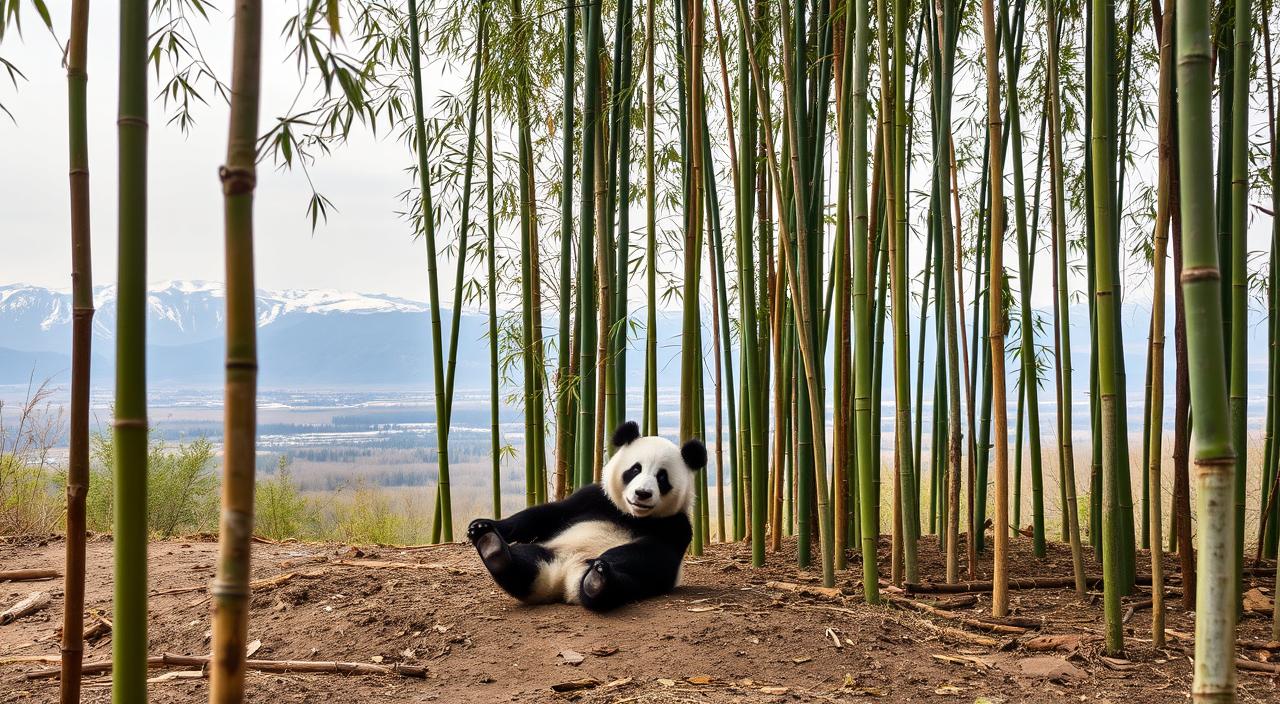Climate Change Affect: Giant pandas are loved worldwide for their cute looks and unique features. Sadly, they have faced many dangers like poaching and losing their homes. This has made their numbers drop below 2,000, with their living space shrinking to less than 1 percent of what it once was.
Thanks to conservation, pandas are not extinct yet. But, rising temperatures could undo all the good work done. Studies warn that pandas might lose their homes by the end of the century. By 2070, half of their habitat could disappear because of climate change, which harms the bamboo they eat.
Key Takeaways
- Giant panda populations have declined dramatically due to poaching and habitat destruction over the past 3,000 years.
- Climate change poses a significant threat to the remaining panda habitat, with projections indicating that half of it may vanish by 2070.
- Global temperatures have already risen by 1.5 degrees Fahrenheit, and further increases of 1 to 6 degrees by 2100 are expected.
- Bamboo, which makes up 99% of the giant panda’s diet, is expected to become unsuitable for survival within the next 50 to 100 years due to climate change.
- Conservation efforts must now account for the impacts of climate change on panda habitats and find ways to mitigate these threats.
Dwindling Panda Habitat Due to Climate Change
Historical Decline and Current Threats
The giant panda, a symbol of conservation, faces a severe threat from the climate crisis. Research shows that climate change could reduce their habitat by 60% in 70 years. This is due to reliable data and models, showing most bamboo habitats will soon be unsuitable for pandas.
Human activities like agriculture, logging, and mining have harmed panda habitats for a century. Their range has shrunk to less than 1% of its original size. Despite efforts, only about 2,000 pandas remain in the wild.
The climate crisis adds to the danger, as bamboo habitats may disappear in 50 to 100 years. This would leave pandas without their main food. New areas for bamboo growth are outside panda reserves, where humans live. The fragmented habitats also make it hard for bamboo to move.
The effects of climate change on pandas are severe. A small increase in global temperatures could make pandas lose half their habitat. The global change research program and fourth national climate assessment warn of health impacts and sea levels. But the panda’s plight highlights the climate crisis‘s wide-reaching effects.
“The likelihood of giant pandas adapting to the changing climate on their own is considered low by scientists.”
Bamboo Scarcity: A Matter of Life and Death
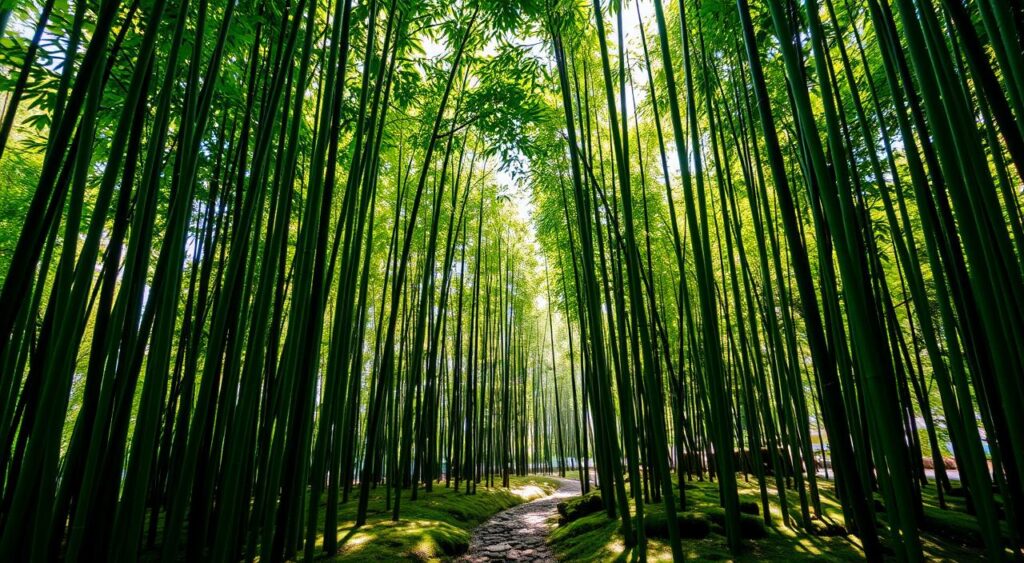
The giant panda’s survival depends on bamboo, its main food. They need to eat 25 to 50 pounds of bamboo daily. This leaves them little room to adapt to environmental changes.
Even if bamboo could move to new places, its low nutritional value is a problem. It makes pandas tired and hard to reproduce. They struggle to move or find new food sources.
The giant panda’s ability to adapt to climate change is very low. An 83% drop in bamboo shoots in Volcanoes National Park (VNP) from 2013 to 2018 shows the danger. As bamboo becomes scarce, the giant panda’s future is uncertain.
| Statistic | Value |
|---|---|
| Decline in newly regenerated bamboo shoots in VNP (2013-2018) | 83% |
| Bamboo shoots in annual feeding time of mountain gorillas | 15% |
| Bamboo shoots in annual feeding time of golden guenons | 60% |
Climate change is affecting bamboo growth and where it grows. Changes in temperature and rain are key factors. Without action, climate change will worsen, threatening the giant panda’s survival.
“The likelihood of these animals adapting on their own to a changing world is therefore low, putting their survival at serious risk as climate change decimates their bamboo food sources.”
The Struggle to Adapt
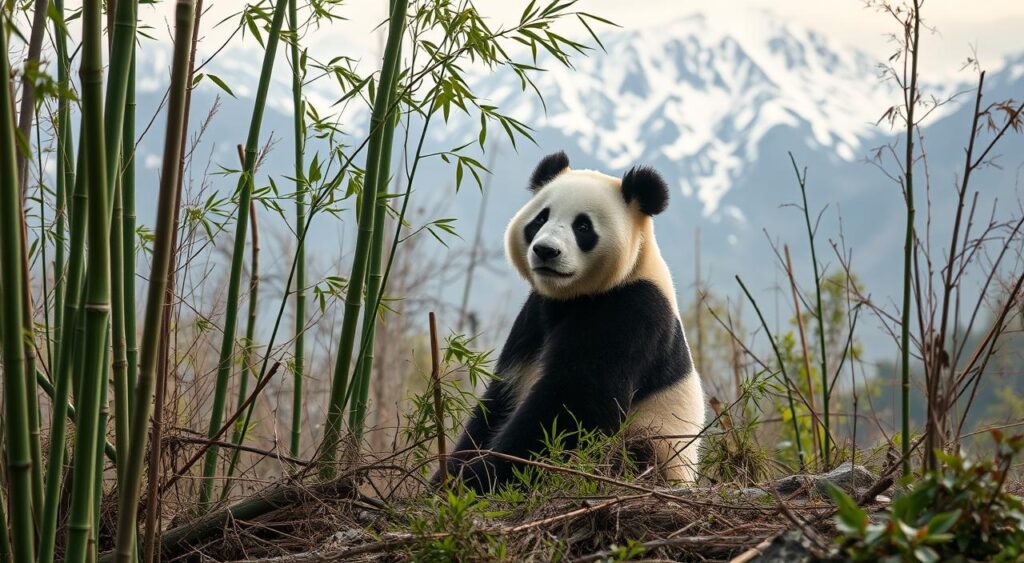
Giant pandas face big challenges as the climate changes. Their diet of almost only bamboo means they have little energy. This makes it hard for them to move to new places as their homes change.
They also have low mobility and face reproductive issues. These problems make it even harder for them to adapt to climate change.
Low Mobility and Reproductive Challenges
Giant pandas are very slow and have little energy. They can barely move, let alone find new homes as their food sources change.
They also have trouble reproducing. This makes it hard for them to adapt to climate changes that are likely to increase soon.
With their slow movement and reproductive issues, giant pandas struggle to adapt to climate change 2021 and beyond. Their chances of adapting successfully are low, putting their survival at risk.
“The likelihood of these animals adapting on their own to a changing world is therefore low, putting their long-term survival at serious risk.”
climate change affect Fragmentation and Isolation
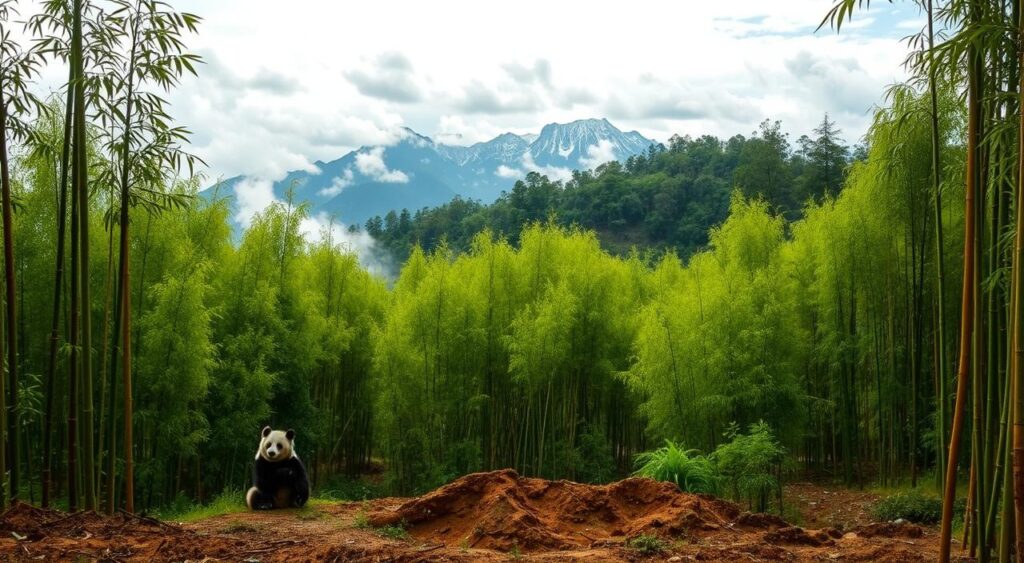
Climate change is making pandas move deeper into China’s mountains for bamboo. This makes their populations more broken and at risk of dying out. The mass deaths of bamboo, which happens every 65 to 120 years, is expected soon.
The future of pandas looks uncertain due to climate change. Their homes are changing, making their groups smaller and more isolated. This could be very bad for their survival.
Loss of habitat and inbreeding in small groups are also threats. As climate change gets worse, pandas will face even more challenges to survive.
“The joint influence of warming and fragmentation on eco-evolutionary dynamics remains unexplored, yet these dynamics can impact phenotypic traits, population dynamics, and ecosystem functioning – all of which are crucial for species persistence under rapid environmental change.”
To help pandas, we need to act now to adapt to climate change. We must keep their habitats connected. This way, we can ensure pandas continue to thrive despite the challenges of climate change.
Conservation Strategies for a Changing Climate
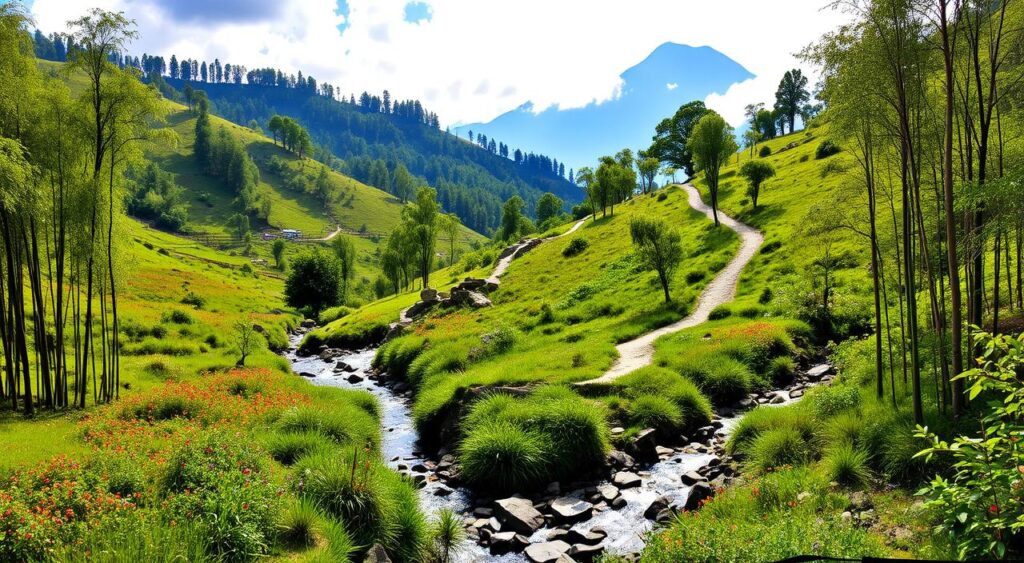
Scientists are working hard to save giant pandas from climate change. They know climate change is expected to change the pandas’ bamboo homes. So, they’re finding new ways to help the pandas adapt.
Proactive Measures and Habitat Connectivity
One idea is to climate change may plant bamboo in new places. This way, they can prepare for where pandas might live in the future. They also plan to connect isolated pandas with “natural bridges”. This lets pandas move and find food as their homes change.
Bringing new pandas to isolated groups is another key plan. This boosts their genetic diversity. It helps them face the challenges of severity of climate change better.
Without action, the giant panda’s future is unsure. But, by protecting their homes and helping them adapt, scientists aim to save this iconic species. They want to make sure pandas thrive for many years.
“The success of panda conservation in the face of climate change will depend on our ability to anticipate and respond to the shifts in their bamboo-dominated habitat.”
Also Read: Pandas and Sustainability: How Bamboo Forests Hold the Key to the Future
Conclusion
The giant panda’s story shows how climate change affects nature. Once on the brink of extinction, pandas are now recovering thanks to conservation. But, climate change threatens their homes and food in the next century. We must fight climate change and adapt conservation to save pandas.
The fate of the giant panda is a wake-up call for climate change action. Climate change is real and harms ecosystems. We must act fast to protect pandas and other endangered species.
In the United States, climate change brings many problems, like rising seas and extreme weather. Human-induced climate change is the main cause. We need to tackle climate change now to save pandas and other species.
FAQs
Q: How do climate change impacts affect pandas and their habitats?
A: Climate change impacts lead to habitat loss and degradation for pandas, as their bamboo food sources become less reliable due to changing temperatures and precipitation patterns.
Q: What are the future effects of climate change on panda populations?
A: Future effects of climate change may include further loss of habitat, reduced genetic diversity, and increased competition for resources, which could threaten the survival of panda populations.
Q: How can extreme weather events impact panda habitats?
A: Extreme weather events, such as heavy rainfall and droughts, can disrupt the growth of bamboo forests, leading to food shortages for pandas and affecting their overall health.
Q: What is the relationship between climate change and agriculture in panda regions?
A: Climate change can disrupt agriculture in regions where pandas live, potentially leading to increased human-panda conflict as farmers expand into panda habitats to compensate for crop failures.
Q: How does global climate change affect the health of pandas?
A: Global climate change affects the health of pandas by altering their diet and habitat, which can lead to malnutrition and increased susceptibility to disease.
Q: What impacts does climate change have on human health in panda regions?
A: Climate change impacts, such as altered weather patterns and increased natural disasters, can lead to health threats for local human populations, which may also affect conservation efforts for pandas.
Q: Why are developing countries particularly vulnerable to climate change when it comes to wildlife conservation?
A: Developing countries often lack the resources and infrastructure to effectively address the consequences of climate change, making them more vulnerable to its impacts on wildlife, including pandas.
Q: How can climate action help protect pandas and their environment?
A: Climate action, such as reducing greenhouse gas emissions and promoting sustainable land use, can mitigate the effects of climate change, helping to preserve panda habitats and support their populations.
Q: What role do intergovernmental panels on climate change play in addressing the threats to pandas?
A: Intergovernmental panels on climate change provide vital research and recommendations on mitigating climate change effects, which can inform policies aimed at protecting vulnerable species like pandas.
Source Links
- https://www.edf.org/giant-pandas-face-greatest-threat-yet-hotter-world
- https://www.carbonbrief.org/climate-change-not-the-only-threat-to-giant-pandas-study-says/
- https://lastchanceforclimate.com/giant-panda-climate-change/
- https://www.nature.com/articles/s41598-019-49519-w
- https://www.ncbi.nlm.nih.gov/pmc/articles/PMC9161982/
- https://www.ipcc.ch/srccl/chapter/chapter-5/
- https://www.un.org/en/climatechange/climate-adaptation
- https://coastadapt.com.au/barriers-to-adapting-climate-change
- https://climatepromise.undp.org/news-and-stories/what-climate-change-adaptation-and-why-it-crucial
- https://www.ncbi.nlm.nih.gov/pmc/articles/PMC7614044/
- https://elifesciences.org/reviewed-preprints/98056
- https://www.ncbi.nlm.nih.gov/pmc/articles/PMC4752022/
- https://www.oregonconservationstrategy.org/key-conservation-issue/climate-change/
- https://www.apha.org/-/media/Files/PDF/topics/climate/Guide_Conclusion.pdf
- https://climatechange.chicago.gov/climate-impacts/climate-impacts-human-health
- https://climatechange.chicago.gov/climate-change-science/future-climate-change

